-
Knowing exposure risks crucial to saving structures from wildfires
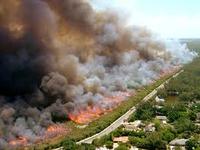
A recent study of one of California’s most devastating wildland fires strongly suggests that measures for reducing structural damage and property loss from wildland urban interface (WUI) fires are most effective when they are based on accurate assessments of exposure risks both for individual structures and the community as a whole.
-
-
U.S. “black budget” reveals unwieldy bureaucracy, misplaced priorities: expert
Classified budget figures and successes and failures by American intelligence agencies, exposed for the first time this week by the Washington Post, show a massive bureaucracy with misplaced priorities, according to a cybersecurity and privacy expert. “The major failure identified in all of the post-9/11 assessments was a ‘failure to connect the dots,’” the expert said. “Nevertheless, the vast majority of the black budget is being spent on data acquisition — collecting more dots — rather than analysis.”
-
-
Deflecting asteroids to protect Earth
Potential asteroid impact on Earth can have disastrous consequences. In order to prevent such collisions, earthbound space objects must be deflected. This can be accomplished using a space probe to impact the asteroid.
-
-
Using desalination to secure water in the desert
Researchers are working on an innovative project to secure water supplies in desert communities which suffer from having an acute shortage of fresh water, but abundant hypersaline groundwater. Hypersaline water is even saltier than seawater.
-
-
Shale gas threatens U.S. nuclear power industry
The U.S. nuclear industry is facing a new enemy, and it is not anti-nuclear peacenicks. It is the shale gas boom, which on Tuesday claimed yet another victim when Entergy Corporation said it would close its Vermont Yankee reactor ahead of schedule. It is the fourth U.S nuclear plant to be closed this year, as utilities have concluded that investing in refurbishing older reactors is no longer economically viable.
-
-
Sandy Task Force issues sixty-nine rebuilding recommendations
The Hurricane Sandy Rebuilding Task Force, appointed by President Obama and chaired by Housing and Urban Development secretary Shaun Donovan, last week release its much-anticipated report, in which it lays out sixty-nine policy recommendations for improving areas affected by Hurricane Sandy last October. The report stressed the importance of investment in new and better construction to withstand increasingly dangerous storms and surges caused by climate change.
-
-
Jersey shore towns build protection against future storms
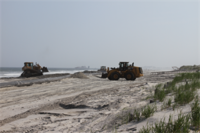
Mantoloking and Brick townships in New Jersey were among the hardest hit by Superstorm Sandy. The storm also destroyed the natural dune barriers which offered a measure of protection. The two cities have decided to take action to minimize the damage of inflicted by a future storm: a $40 million project will see a steel wall —extending sixteen feet above the beach with a depth of thirty-two feet below the ground, and covered in sand to form an artificial dune — will run along the length of the two towns.
-
-
Fukushima radioactive plume to reach U.S. next year
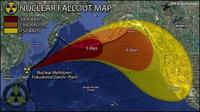
The radioactive ocean plume from the 2011 Fukushima nuclear plant disaster will reach the shores of the United States within three years from the date of the incident, but is likely to be harmless, according to a new study. While atmospheric radiation was detected on the U.S. west coast within days of the incident, the radioactive particles in the ocean plume take considerably longer to travel the same distance.
-
-
Understanding the effects of wildfire smoke improves climate change models
Where there is wildfire, there is smoke — a lot of it. Those vast, carbon-laden clouds released by burning biomass can play a significant role in climate change. Not much is known, however, about the different types of particles in wildfire smoke and how they affect climate. Now researchers have uncovered some of their secrets. In particular, they studied an important component of smoke that has so far been absent from most models of climate change.
-
-
Beach erosion by Hurricane Sandy leaves coastal communities more exposed to future storms
Barrier islands provide natural protection against storms, shielding coastlines from rising waves and tides. Beaches and dunes on Fire Island, New York, lost more than half of their pre-storm volume during Hurricane Sandy, and the loss of so much sand increases the vulnerability of this area of coastline to future storms.
-
-
Remapping coastal areas damaged by Hurricane Sandy
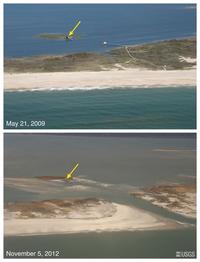
Hurricane Sandy caused wide-scale landscape-altering destruction, resulting in an estimated damage of $50 billion, making Sandy the second-costliest cyclone to hit the United States since 1900. “Sandy’s most fundamental lesson is that storm vulnerability is a direct consequence of the elevation of coastal communities in relation to storm waves,” says USGS Kevin Gallagher. Three federal agencies are using ships, aircraft, and satellites to measure water depth, look for submerged debris, and record altered shorelines in high priority areas from South Carolina to Maine.
-
-
Demolition of building allows study of earthquake along Calif. Hayward Fault
In an effort to track which area of California’s East Bay would suffer the worst shaking in future earthquakes caused by the dangerous Hayward Fault, the U.S Geological Survey (USGS) initiated an artificial earthquake through the densely populated area of valleys and hills across bay from San Francisco.
-
-
Bay Bridge repairs expensive, slow
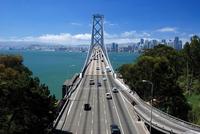
California’s 8-mile San Francisco-Oakland Bay Bridge was designed and built in the 1930s in about 5.5 years at a cost of $78 million, well under budget and ahead of schedule. Presently, the 2-mile eastern span of the bridge needs to be replaced, and it has taken the state five years just to design the replacement. Construction is taking about three times the expected time, and the $6.4 billion budget is almost five times the estimate provided by engineers.
-
-
Aquifer supplying a third of U.S. irrigated groundwater depleting quickly: study
The High Plains Aquifer of Kansas — also called the Ogallala Aquifer — supplies 30 percent of the U.S. irrigated groundwater. New study finds that if current irrigation trends continue, 69 percent of the groundwater stored in the High Plains Aquifer will be depleted in fifty years.
-
-
Post-Sandy infrastructure must be more resilient: Sandy Task Force
The task force appointed by President Barack Obama, charged with developing a strategy for rebuilding areas damaged by Superstorm Sandy, has urged coastal communities to recognize that owing to climate change, storms are going to be more frequent and more destructive, and that floods are going to occur more frequently. The best way to prepare for the more extreme weather ahead is to build a more robust and resilient infrastructure that can withstand the more demanding challenges.
-
More headlines
The long view
Helping Strengthen America’s Critical Infrastructure
Everyday life depends on a robust infrastructure network that provides access to running water, communications technology and electricity, among other basic necessities. The experts who keep our national infrastructure secure and resilient also need a strong network to share their knowledge and train the next generation of professionals capable of solving complex infrastructure challenges.
AI and the Future of the U.S. Electric Grid
Despite its age, the U.S. electric grid remains one of the great workhorses of modern life. Whether it can maintain that performance over the next few years may determine how well the U.S. competes in an AI-driven world.
Using Liquid Air for Grid-Scale Energy Storage
New research finds liquid air energy storage could be the lowest-cost option for ensuring a continuous power supply on a future grid dominated by carbon-free but intermittent sources of electricity.
Enhanced Geothermal Systems: A Promising Source of Round-the-Clock Energy
With its capacity to provide 24/7 power, many are warming up to the prospect of geothermal energy. Scientists are currently working to advance human-made reservoirs in Earth’s deep subsurface to stimulate the activity that exists within natural geothermal systems.
Experts Discuss Geothermal Potential
Geothermal energy harnesses the heat from within Earth—the term comes from the Greek words geo (earth) and therme (heat). It is an energy source that has the potential to power all our energy needs for billions of years.
